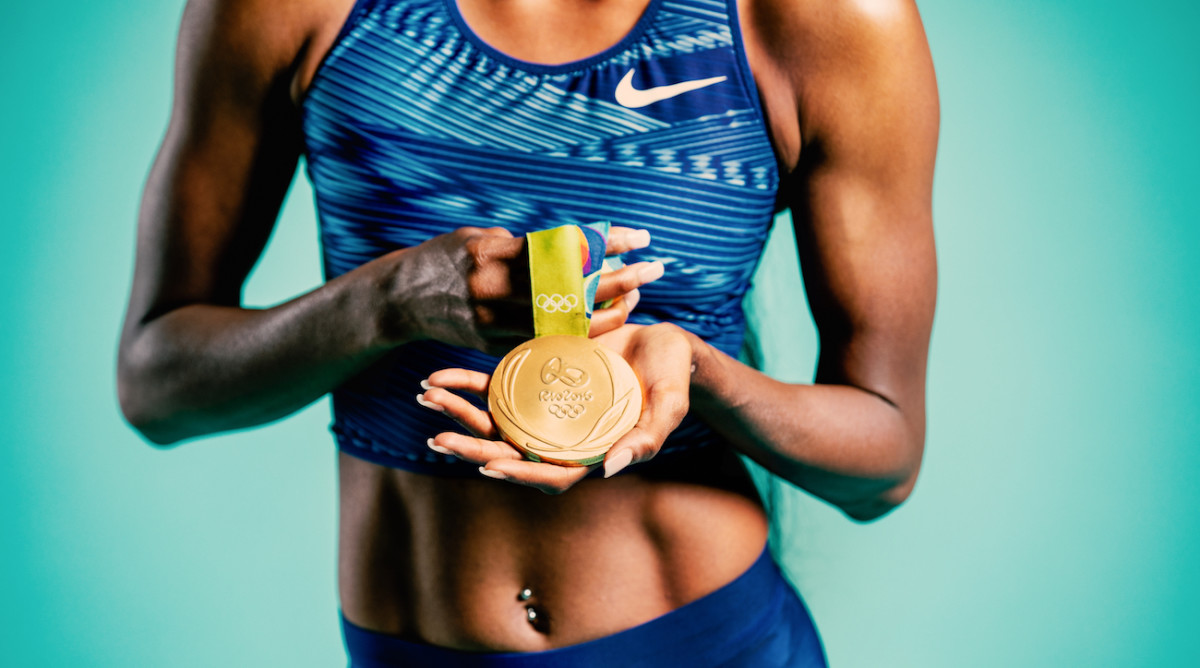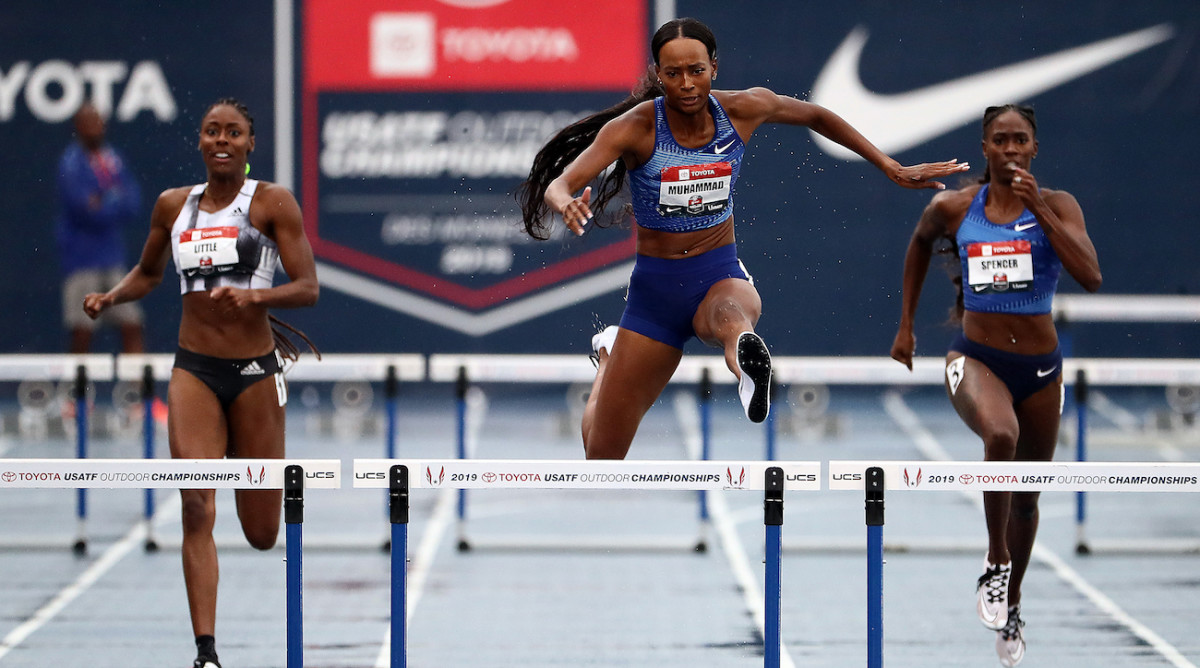The Imperfect World Record: Examining Dalilah Muhammad’s 400-Meter Hurdles Race

Last October, renowned hurdles coach Lawrence Johnson called Dalilah Muhammad over the phone to debrief on their 2018 season. Muhammad's season’s best of 53.65 in the 400-meter hurdles was her slowest since 2015, she won just three of the seven Diamond League races that she competed in and decided to bypass the U.S. Outdoor Track and Field Championships without a world championship or Olympic team to make. The “off-year” was certainly an off-year for the Olympic champion.
“Why do you do this?” Johnson asked.
Without much hesitation, she said, “Because I really love to do it.”
Johnson jokes that it was not the answer he was expecting. At 29, the Queens, N.Y. native has come a long way from finishing 5th in the 400-meter hurdles at the 2012 NCAA Championships for USC, exiting the 2012 Olympic Trials in the first round and pursuing a professional career as an unsponsored hurdler in 2013. Backed by her family, she made her first world championship team in 2013 and landed a sponsorship contract with Nike. Despite injuries in 2014 and 2015, Muhammad has still earned a decent amount from race appearances and winnings since her gold medal at the 2016 Olympics. She could have told Johnson she did it for the money but this is still track and field that they were talking about. Even the sport's best athletes aren't compensated enough for their talent.
“What type of footprint do you want to leave on the sport?" Johnson recalls asking next. "When they say ‘Dalilah Muhammad’ in 10 or 20 years from now, what do you want them to say?”
“She was the best,” Muhammad responded.
“The best? Or the best ever?” he said.
“The best that ever did it,” she affirmed.
Similar phone conversations took place several times throughout the fall and spring. The pair came to an agreement that two things stood in the way of actually making Muhammad the best: An American record and a world record. If they trained right and planned properly, they could try to achieve both in the same race.
“This was not about beating individuals," Johnson says. "There are some great athletes out there and that’s cool. But this season was about being the best ever. Everything that we’ve done was set on the course to be the very best ever.”
Muhammad spent the fall of 2018 focusing on strength and foundational work during long and arduous training days. Among the early workouts that stuck out were multiple 12 x 400-meter sessions with 60 seconds rest. Each lap had to be run between 70 and 72 seconds. She would nail the times and come back the next day to run a mile time trial anywhere from 5:07 to 5:17. For 800-meter work, she could comfortably run 2:06 and she believed in a race, she’d dip under two minutes. She didn’t start going over hurdles until March when she started getting under world record pace in practice over eight and nine hurdles. In a two-year span, she'd been able to take a second off her splits over those respective hurdles in practice – a significant amount of time in the intermediate hurdles.

In early July, Dalilah was on the track at in Los Angeles doing short sprints during a normal training session when she stumbled. Her teammates say she was moving so fast that she hit the ground, bounced and hit the surface a second time. Muhammad recalls extending her arms before her head hit the track. She winced in pain but more so in fear that the skin on her face was scraped. She popped back up and didn’t report feeling any pain.
"I started asking my teammates some weird questions like, ‘Did I finish practice?’ ‘Did we move?’ ‘How did we get here?’” Muhammad says. “I couldn’t make sense of what was going on around me. I was losing track of time. I was going in and out of consciousness where I’d be on one spot talking to someone and the next moment, I’m somewhere else.”
She went to the emergency room and was told that she had experienced a mild concussion. Aside from a few hand wounds and scrapes around her ankles, she was fine and back to running light workouts three days later. With a week to go until the U.S. Championships, Johnson called his brother, Chris (the associate head coach at Arkansas and 2015 world championship 400m hurdle silver medalist Shamier Little’s coach), to run a crazy idea by him.
“Do you think it’s crazy for me to get Dalilah to the eighth hurdle at 35 seconds flat?” he asked. Most of the top 400-meter hurdlers clear those hurdles comfortably around 37 seconds. Aiming for two seconds of insurance would put Muhammad in the clear for her world and American record goal.
“Only if she does it,” his brother responded before they broke out into laughter.
It had rained in Rio de Janeiro just before Muhammad won Olympic gold. The rain and similarly soggy track in Des Moines’ during the U.S. Championships, therefore, wasn't a concern for Johnson and Muhammad. They had spent the previous Thursday, Friday and Saturday monitoring the wind patterns and examined the negative wind readings for the men’s and women’s 100-meter finals and women’s 100-meter hurdle final. The weather for July 28th predicted that wind would be in the hurdlers’ faces as they came down the homestretch and toward the finish line. They devised different race approaches in case, but the rain didn't bring any wind during the race. Johnson's final point of focus was for Muhammad to trust herself and what she was feeling in the moment.
The race started just after 7 p.m. at Drake Stadium. Muhammad had the slowest start out of all eight finalists when she popped out of the blocks in Lane 4 with a 0.287 reaction time.
“That usually doesn’t happen,” Johnson says. “That cost us right there. She reacts well to the sound of the gun but this time it took her a moment to process it.”
Little, who was in Lane 5, tied for the fastest reaction time (0.198 seconds) and was the first over the first two hurdles. Muhammad was even with her over the next three before she pulled away from the field.

Muhammad’s initial plan was to take 15 steps between hurdles through the first nine hurdles. She planned to be on her right dominant leg and then switch over on the 10th. The plan changed when she took the lead. Muhammad then made the leg change over the eighth hurdle just 36.39 seconds into the race.
The eighth or tenth hurdle can tend to be a problem for top hurdlers since they're moving fast and are more comfortable shortening their steps to remain on their dominant leg as opposed to allowing their non-dominant leg to come over the hurdle. Muhammad decided not to chop her steps and went with the fluid motions of the race to switch legs. She was trusting herself as Johnson had instructed.
“When you’re trying to break a world record, you have to take some risks,” Muhammad says. “A huge risk can see a huge reward or you can fall flat. I knew that was a possibility in me taking a risk halfway through the race on not even the world record but just making the team. It’s a lot of pressure to say the least. A lot of doubt can get in your mind but that’s natural with the sport. I was thinking, ‘Do I just go for it? Do I just go for securing my spot on the team? Do I try to go for the world record?’ You have to stay focused on your goals.”
Johnson looks back at the switch as a “big mistake," but taking a similar risk had previously paid off for Muhammad when she made the same switch during the 2017 U.S. Outdoor Championships in Sacramento, where she ran 52.64 to win what remains the deepest 400-meter hurdle race in history. Six women went under 54 seconds and three women went under 53. Two of them, Little and Ashley Spencer, were also in Sunday’s race in Des Moines. (Kori Carter, who was third in the 2017 race, won that summer’s world championships and did not race in the 2019 U.S. final since she had a bye to defend her title.) Switching legs throws off a hurdler’s natural rhythm and slightly slows the race down.
In Des Moines, Little, Spencer and 2016 Olympian Sydney McLaughlin were charging behind Muhammad as she pulled away after the sixth hurdle. Four of the most dangerous finishers in the world were competing for just three spots heading to September’s IAAF World Championships in Doha.
“If you’re out there and you’re leading, you can get that ‘Oh s--t!’ feeling,” Johnson says. “You don’t know where you are because you can’t hear anything. It’s kind of unsettling a little bit. I think maybe she switched at eight because maybe she thought she was moving too fast or doing too much.”
Muhammad heard Johnson’s voice by the eighth hurdle when he yelled, “Drop your arms!” When Muhammad finds her groove, she tends to start carrying her arms just a little higher, which shortens her stride length and may result in taking an extra step. Dropping her arms opens up her stride to feel smoother and less stressed.
She avoided disaster at the eighth hurdle and by the ninth, Muhammad had gapped McLaughlin and Spencer.
Johnson calls Muhammad’s tenth hurdle “decent” and she thinks it was “terrible” Some time was lost because she hung in the air for too long and her lead leg was a little too far extended.
“I think I slowed down in the last two steps before the finish line,” Muhammad says. “You always have that panicked feeling that you could get caught but it wasn’t until that point that I knew how far away I was and how big of a gap I had created.”
Muhammad crossed the finish line in 52.20 to take .14 seconds off Yuliya Pechonkina’s world record, which had stood for 16 years.
“If she ran the perfect race, I think she would have run 51.6 or 51.7,” Johnson says.
Since 2003, Americans had come close to Pechonkina. When Lashinda Demus won gold for the United States at the 2011 world championships, her 52.47 was the closest that any American woman had come before Muhammad. Athletes like Demus, Kim Batten and Tonja Buford-Bailey are among the reasons why the event has been popularized and improved in the past decade.
In the last 10 years, American women have won 12 of 24 Olympic or world championship medals in the event but still, none had broken the long-standing record until Muhammad.
“I definitely think it’s going to be broken,” Muhammad says. “I don’t see it lasting 16 years like the previous one. I definitely feel like I have more to give if you set up a more perfect race. It’s possible it could happen at the world championships in Doha.”
Muhammad defeated a field that included four global championship medalists and the teen phenom McLaughlin, who race announcers focused much of the pre-race talk around her own world record hopes. After all, she turned 20 years old on Aug. 7th, had beaten Muhammad earlier in the year and holds a personal best of 52.75 from May 2018.
“I think the floodgates are wide open,” Johnson says. “People will go back to their respective training camps to get there. We understood going in that was the deal. As soon as their coaches see Dalilah in the lineup, they’re going to bring everything they’ve got.”
Someone will break Muhammad’s record—but she might just do it herself first.
